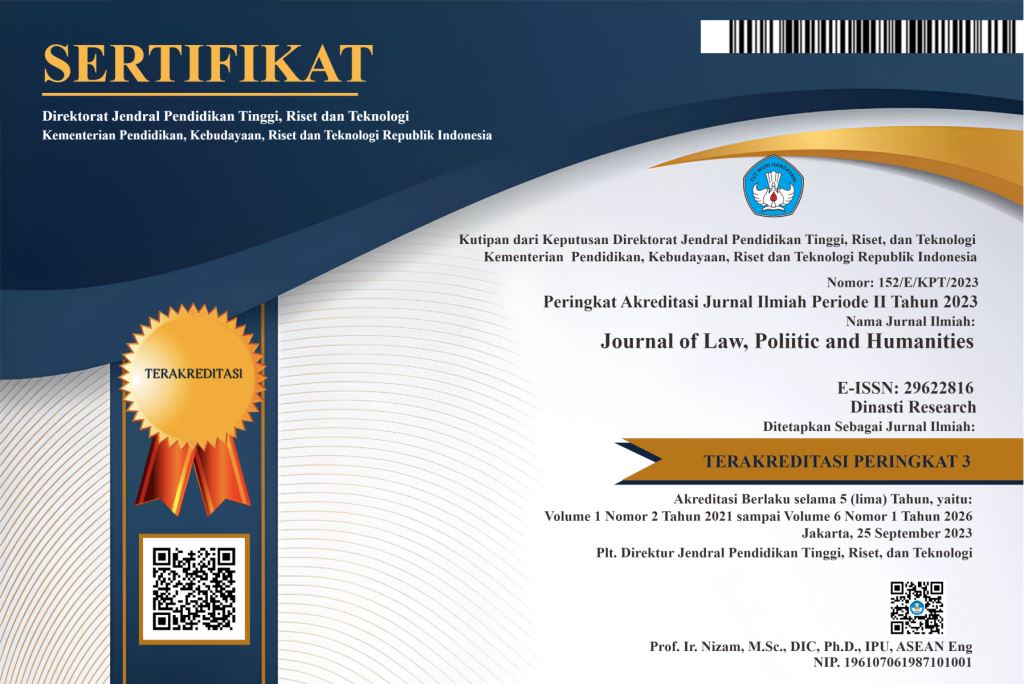The Execution of Burning of Seized Narcotics Goods in Open Space on Environmental Health from a Rights Perspective
DOI:
https://doi.org/10.38035/jlph.v5i4.1353Keywords:
Execution of Judgement,, Destruction of Narcotics,, Human RightsAbstract
In the verdict of a narcotics case, the destruction of confiscated narcotics is usually one of the rulings that must be implemented. In Indonesia, the method of destroying confiscated narcotics goods that is commonly used in the execution of decisions in the form of destroying confiscated narcotics goods is by using the open burning method. However, this method of burning confiscated goods is considered to potentially violate human rights because it affects the environment and public health. This research aims to find out how human rights views on the open burning of confiscated narcotics and to determine the destruction procedure that is in accordance with human rights standards in Indonesia. The research method used in this research is socio-legal by using descriptive analytical research specifications. The research stages were carried out with secondary data library research and field research in the form of interviews with the National Narcotics Agency. Based on the results of the research, it can be concluded that the method of burning confiscated narcotics in open spaces can violate human rights. This is because the smoke from the combustion still contains high levels of dangerous narcotic substances, thus violating the right to a clean, healthy and sustainable environment. Furthermore, regarding the method of destroying confiscated narcotics that is safe for the environment and the surrounding community, namely using an incinerator. This is because incinerators do not produce smoke from combustion, so they do not pollute the environment and are not harmful to the surrounding community
References
Aisyah, A., & Sahari, A. (2022). Destruction of Seized Goods for Narcotics Crimes in the Context of Preventing Irregularities in the Re-Circulation of Seized Goods in the Community (Study at the Belawan District Attorney's Office). JOURNAL DOCTRINE REVIEW, 1(1), 152–162.
Cone, E. J., Bigelow, G. E., Herrmann, E. S., Mitchell, J. M., LoDico, C., Flegel, R., & Vandrey, R. (2015). Non-smoker exposure to secondhand cannabis smoke. I. Urine screening and confirmation results. Journal of Analytical Toxicology, 39(1), 1–12.
Diani, A. D. A. A. (2015). The Effect of Destruction of Narcotics Seized Goods on the Strength of Evidence at Trial. Porch of Law, 8(02), 23099.
Eduward, E., Mulyadi, M., Ablisar, M., & Purba, H. (2016). Execution of Evidence of Narcotics Crimes Seized for the State (Study of Decisions of Judges of the Balige District Court). USU Law Journal, 4(2), 131–141.
Eko Riyadi, S. H. (2019). Human Rights Law: international, regional and national perspectives. Rajawali Press.
Hakim, L., & Kurniawan, N. (2021). Building an Indonesian Human Rights Law Paradigm Based on Human Rights Obligations. Journal of the Constitution, 18(4), 869–897.
Hall, W., & Degenhardt, L. (2014). The adverse health effects of chronic cannabis use. Drug Testing and Analysis, 6(1–2), 39–45.
Harahap, M. Y. (2006). Discussion of Problems and Application of KUHAP: Investigation and Prosecution Second Edition/M. Yahya Harahap.
Hariantika, R. D., & Sukinta, B. D. B. (2016). The Process of Destruction of Drug Evidence Before the Judge's Verdict in the Legal Area of Semarang Polretbes. Diponegoro Law Journal, 5(4), 1–20.
Jiang, F., Li, S., Pan, L., Zhang, N., & Jia, C. (2014). Association of anxiety disorders with the risk of smoking behaviours: a meta-analysis of prospective observational studies. Drug and Alcohol Dependence, 145, 69–76.
Lee, D., & Huestis, M. A. (2014). Current knowledge on cannabinoids in oral fluid. Drug Testing and Analysis, 6(1–2), 88–111.
Saura-Freixes, N. (2022). Environmental human rights defenders, the rule of law and the human right to a healthy, clean and sustainable environment: recent trends and challenges. UNIO-EU Law Journal, 8(1), 53–79.
Supramono, G. (2009). Indonesian drug law. Djambatan.
Susastrio, H., Ginting, D., Sinuraya, E. W., & Pasaribu, G. M. (2020). Incinerator Study as One of the Gasification Methods in an Effort to Reduce Urban Waste. Journal of New and Renewable Energy, 1(1), 28–34.
Tamanaha, B. Z. (1997). Realistic socio-legal theory: Pragmatism and a social theory of law. Oxford university press.
Tribunnews. (2023). BNN reveals 910 cases and thousands of drug evidence throughout 2023. https://www.tribunnews.com/nasional/2023/12/28/bnn-ungkap-910-kasus-beserta-ribuan-barang-bukti-narkoba-sepanjang-tahun-2023
Wiratraman, H. P. (2008). Socio-Legal Research and its Methodological Consequences. Surabaya: Centre of Human Right Law Studies (HRLS), Faculty of Law, Universitas Airlangga, Tt.
Downloads
Published
How to Cite
Issue
Section
License
Copyright (c) 2025 Gazhy Diemas Prahadi, Erika Magdalena Chandra, Ajie Ramdan

This work is licensed under a Creative Commons Attribution 4.0 International License.
Authors who publish their manuscripts in this journal agree to the following conditions:
- The copyright on each article belongs to the author(s).
- The author acknowledges that the Journal of Law, Poliitic and Humanities (JLPH) has the right to be the first to publish with a Creative Commons Attribution 4.0 International license (Attribution 4.0 International (CC BY 4.0).
- Authors can submit articles separately, arrange for the non-exclusive distribution of manuscripts that have been published in this journal into other versions (e.g., sent to the author's institutional repository, publication into books, etc.), by acknowledging that the manuscript has been published for the first time in the Journal of Law, Poliitic and Humanities (JLPH).


























